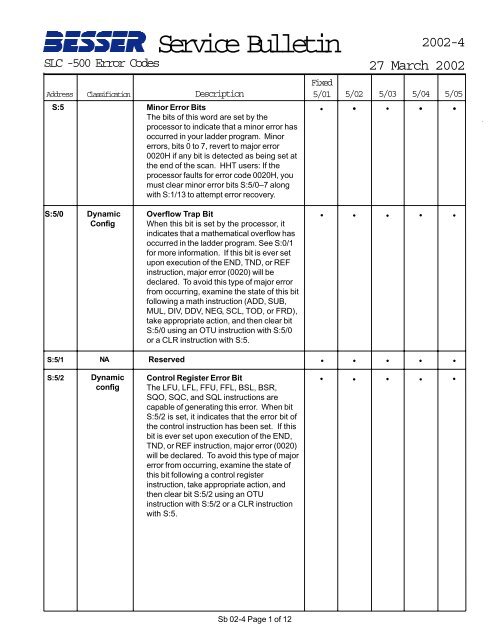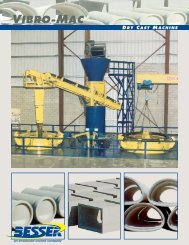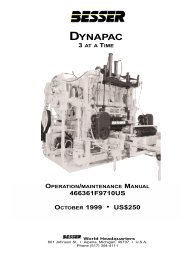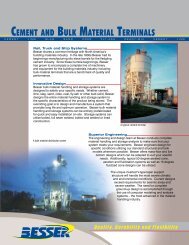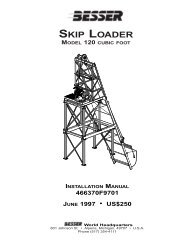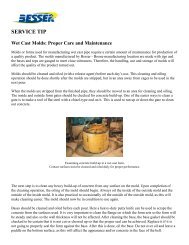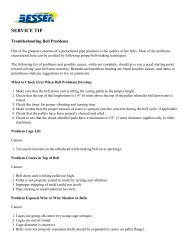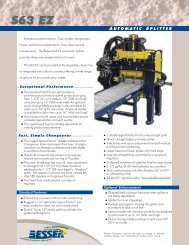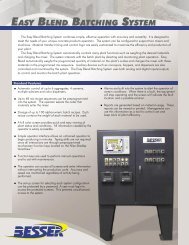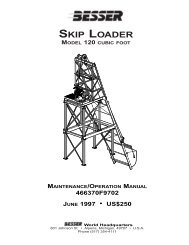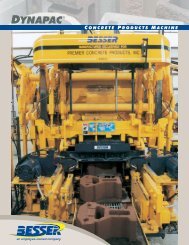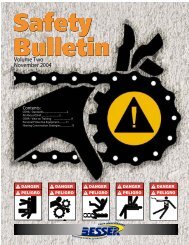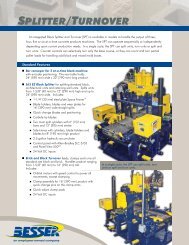SLC-500 Error Codes.pdf
SLC-500 Error Codes.pdf
SLC-500 Error Codes.pdf
You also want an ePaper? Increase the reach of your titles
YUMPU automatically turns print PDFs into web optimized ePapers that Google loves.
<strong>SLC</strong> -<strong>500</strong> <strong>Error</strong> <strong>Codes</strong><br />
Service Bulletin<br />
Sb 02-4 Page 1 of 12<br />
2002-4<br />
27 March 2002<br />
Address Classification<br />
Description<br />
Fixed<br />
5/01 5/02 5/03 5/04 5/05<br />
S:5 Minor <strong>Error</strong> Bits<br />
The bits of this word are set by the<br />
processor to indicate that a minor error has<br />
occurred in your ladder program. Minor<br />
errors, bits 0 to 7, revert to major error<br />
0020H if any bit is detected as being set at<br />
the end of the scan. HHT users: If the<br />
processor faults for error code 0020H, you<br />
must clear minor error bits S:5/0–7 along<br />
with S:1/13 to attempt error recovery.<br />
• • • • •<br />
S:5/0 Dynamic<br />
Config<br />
Overflow Trap Bit<br />
When this bit is set by the processor, it<br />
indicates that a mathematical overflow has<br />
occurred in the ladder program. See S:0/1<br />
for more information. If this bit is ever set<br />
upon execution of the END, TND, or REF<br />
instruction, major error (0020) will be<br />
declared. To avoid this type of major error<br />
from occurring, examine the state of this bit<br />
following a math instruction (ADD, SUB,<br />
MUL, DIV, DDV, NEG, SCL, TOD, or FRD),<br />
take appropriate action, and then clear bit<br />
S:5/0 using an OTU instruction with S:5/0<br />
or a CLR instruction with S:5.<br />
S:5/1 NA Reserved<br />
• • • • •<br />
S:5/2 Dynamic<br />
config<br />
Control Register <strong>Error</strong> Bit<br />
The LFU, LFL, FFU, FFL, BSL, BSR,<br />
SQO, SQC, and SQL instructions are<br />
capable of generating this error. When bit<br />
S:5/2 is set, it indicates that the error bit of<br />
the control instruction has been set. If this<br />
bit is ever set upon execution of the END,<br />
TND, or REF instruction, major error (0020)<br />
will be declared. To avoid this type of major<br />
error from occurring, examine the state of<br />
this bit following a control register<br />
instruction, take appropriate action, and<br />
then clear bit S:5/2 using an OTU<br />
instruction with S:5/2 or a CLR instruction<br />
with S:5.<br />
• • • • •<br />
• • • • •
Address Classification Description<br />
S:5/3 Dynamic<br />
Config<br />
S:5/4 Dynamic<br />
Config<br />
S:5/5<br />
to<br />
S:5/7<br />
Major <strong>Error</strong> Detected while Executing<br />
User Fault Routine Bit<br />
When set, the major error code (S:6)<br />
represents the major error that occurred<br />
while processing the fault routine due to<br />
another major error.<br />
If this bit is ever set upon ececution of<br />
the END, TND, or REF instruction, major<br />
error (0020) will be declared. To avoid<br />
this type of major error from occurring,<br />
examine the state of this bit inside your<br />
fault routine, take appropriate action, and<br />
then clear bit S:5/3 using an OTU<br />
instruction with S:5/3 or a CLR<br />
instruction with S:5.<br />
Application example:<br />
Suppose you are executing your fault<br />
routine for a fault code 0016H Startup<br />
Protection. At rung 3 inside this fault<br />
routine, a TON containing a negative<br />
preset is executed. When rung 4 is<br />
executed, fault code 0016H is overwritten<br />
to indicated code 0034H, and S:5/3 is<br />
set.<br />
If your fault routine did not determine that<br />
S:5/3 was set, major error 0020H would<br />
be declared at the end of the first scan.<br />
To avoid this problem, examine S:5/3,<br />
followed by S:6, prior to retruning from<br />
your fault routine. If S:5/3 is set, take<br />
appropriate action to remedy the fault,<br />
then clear S:5/3.<br />
M0-M1 Referenced on Disabled Slot<br />
Bit<br />
This bit is set whenever any instruction<br />
references an M0 or M1 module file<br />
element for a slot that is disabled (via its<br />
I/O slot enable bit). When set, the bit<br />
indicates that an instruction could not<br />
execute properly due to the unavailability<br />
of the addressed or M0 or M1 data.<br />
If this bit is ever set upon execution of<br />
the END, TND, or REF instruction, major<br />
error (0020) is declared. To avoid this<br />
type of major error from occurring,<br />
examine the state of this bit following a<br />
M0-M1 referenced instruction, take<br />
appropriate action, and then clear bit S:5/<br />
4 using and OTU instruction with S:5/4 or<br />
a CLR instruction with S:5.<br />
Sb02-4 Page 2 of 12<br />
Fixed<br />
5/01 5/02 5/03 5/04 5/05<br />
• • • •<br />
• • • •<br />
NA Reserved<br />
Reserved for minor errors that revert to<br />
major errors at the end of the scan.<br />
• • • • •
Address Classification Description<br />
S:5/8 Status Memory Module Boot Bit<br />
When this bit is set by the processor, it<br />
indicates that a memory module<br />
program has been transferred to the<br />
processor. This bit is not cleared by the<br />
processor.<br />
Your program can examine the state of<br />
this bit on entry into the REM Run mode<br />
to determine if the memory module<br />
content has been transferred. Bit S:1/15<br />
will be set to indicate REM Run mode<br />
entry. This information is useful when<br />
you have an application that contains<br />
retentive data and a memory module that<br />
has only bit S:1/10 set (Load Memory<br />
Module on Memory error). Use this bit<br />
to indicate that retentive data has been<br />
lost. This bit is also helpful when using<br />
bits S:1/11 (Load Memory Module<br />
Always) or S:1/12 (Load Memory Module<br />
Always and Run) to distinguish a power<br />
up REM Run mode entry from a REM<br />
Program (or REM Test) mode to REM<br />
run mode entry.<br />
• • • • •<br />
S:5/10 Status<br />
S:5/11<br />
S:5/12<br />
Status Memory Module Password Mismatch<br />
Bit<br />
This bit is set on REM Run mode entry,<br />
whenever loading from the memory<br />
module is specified (word 1, bits 11 or<br />
12) and the processor user program is<br />
password protected, and the memory<br />
module program does not match that<br />
password.<br />
Use this bit to inform your application<br />
program that an autoloading memory<br />
module is installed but did not load due<br />
to password mismatch.<br />
• • • • •<br />
Status<br />
Status<br />
STI (Selectable Timed Interrupt)<br />
Overflow Bit<br />
This bit is set whenever the STI timer<br />
expires while the STI routine is either<br />
executing or disabled and the pending<br />
bit is already set.<br />
Battery Low Bit<br />
This bit is set whenever the Batter Low<br />
LED is on. The bit is cleared when the<br />
Battery Low LED is off.<br />
Discrete Input Interrupt Overflow Bit<br />
This bit is set whenever the DII interrupt<br />
occurs while still executing the DII<br />
subroutine or whenever the DII interrupt<br />
occurs whild pending or disabled.<br />
Sb 02-4 Page 3 of 12<br />
Fixed<br />
5/01 5/02 5/03 5/04 5/05<br />
• • • •<br />
• • • •<br />
• • •
Address Classification Description<br />
S:5/13<br />
S:5/14<br />
Dynamic<br />
Config<br />
Status<br />
Unsuccessful Operating System Load<br />
Was Attempted<br />
This bit is set whenever an operating<br />
system memory module loade is<br />
attempted and is unsuccessful.<br />
Unsuccessful loads can occur when<br />
either the protection jumper is in the<br />
protect position or is missing, or if the<br />
operating system memory moduleis<br />
incompatible with the <strong>SLC</strong> 5/03, <strong>SLC</strong> 5/<br />
04, or <strong>SLC</strong> 5/05 processors’ hardware<br />
platform. Examine the state of this bit<br />
with your user program to diagnose this<br />
condition.<br />
Channel 0 Modem Lost<br />
This bit indicates the status of the<br />
modem connected to Channel 0 (RS232<br />
serial port). The state of the bit is<br />
determined by:<br />
•the protocol Channel 0 is configured for<br />
•the Control Line selected<br />
•the states of DCD (Data Carrier Detect)<br />
and DSR (Data Set Ready).<br />
If the bit is set, then the modem is not<br />
properly connected to Channel 0 or it is<br />
in a state where unreliable<br />
communication exchanges may take<br />
place via Channel 0. The following<br />
conditions apply:<br />
•If Channel o is disabled or configured for<br />
DH485, the bit is always cleared.<br />
•If Channel 0 is configured for one of the<br />
DF-1 protocols in System Mode or<br />
Generic ASCII in User Mode, then the<br />
Control Line selection determines how<br />
DCD and DSR affect the modem status:<br />
-If Control Line=NO HANDSHAKING:<br />
The bit is always set<br />
-If Control Line=FULL-DUPLEX or HALF-<br />
DUPLEX WITHOUR CONTINUOUS<br />
CARRIER: The bit is set if DSR goes<br />
inactive and cleared when DSR goes<br />
active. (DCD has no affect on modem<br />
status in this case).<br />
-If Control Line=HALF-DUPLEX WITH<br />
CONTINUOUS CARRIER: The bit is set<br />
is either DSR goes inactive or DCD<br />
remaine inactive for more than 10<br />
seconds. This bit is cleared when both<br />
DSR and DCD go active.<br />
Sb02-4 Page 4 of 12<br />
Fixed<br />
5/01 5/02 5/03 5/04 5/05<br />
• • •<br />
•<br />
•<br />
•
Address Classification Description<br />
S:5/15 Status<br />
S:6<br />
Status<br />
ASCII String Manipulation <strong>Error</strong><br />
This bit applies to <strong>SLC</strong>5/03 (OS301and<br />
higher), <strong>SLC</strong> 5/04, and <strong>SLC</strong> 5/05<br />
processors.<br />
This bit is set to 1 when an attempt is<br />
made to process a string using an ASCII<br />
instruction that exceeds 82 characters in<br />
length.<br />
Major <strong>Error</strong> Fault Code<br />
A hexadecimal code is entered in this word<br />
by the processor when a major error is<br />
declared. Refer to S:1/13. The code<br />
defines the type of fault, as indicated on<br />
the following pages. This word is not<br />
cleared by the processor<br />
<strong>Error</strong> codes are presented, stored and<br />
displayed in a hexadecimal format. Refer<br />
to appendix G for more information on the<br />
hexadecimal numbering system.<br />
If you enter a fault code as a parameter in<br />
an instruction in your ladder program, you<br />
must convert the code to decimal. For<br />
example, if you program an EQU<br />
instruction to go true when the error 0016<br />
occurs, enter S:6 as source A and 22, the<br />
decimal equivalent of 0016H, as source B:<br />
Application Example: You can<br />
declare your own application specific<br />
major fault by writing a unique value to<br />
S:6 and then setting bit S:1/13.<br />
<strong>SLC</strong> 5/02 processor users: Interrogate<br />
the value of S:6 in your fault routine to<br />
determine the type of fault that occured.<br />
If your program was saved with the test<br />
single step enabled, you can also<br />
interrogate S:20 and S:21 to pinpoint the<br />
exact rung that was executing when the<br />
fault occurred. Fault Classifications:<br />
Faults are classified as Non-User, Non-<br />
Recoverable, and Recoverable.<br />
Non-User Fault<br />
The fault routine does not execute.<br />
Non-Recoverable User Fault<br />
The fault routine executes for 1 pass.<br />
(You may initiate a MSG instruction to<br />
another node to identify the fault<br />
condition of the processor).<br />
Recoverable User Fault<br />
The fault routine may clear the fault by<br />
clearing bit S:1/13.<br />
Sb 02-4 Page 5 of 12<br />
Fixed<br />
5/01 5/02 5/03 5/04 5/05<br />
•<br />
• • • • •<br />
•<br />
•<br />
•<br />
•<br />
•<br />
•
Address Classification Description<br />
S:6<br />
cont’d<br />
Address Address Address<br />
<strong>Error</strong> <strong>Error</strong><br />
<strong>Error</strong><br />
Code<br />
Code<br />
(Hex)<br />
(Hex) POWERUP OWERUP E EERRORS<br />
E RRORS<br />
S:6<br />
cont’d<br />
0001<br />
0002<br />
0003<br />
0005<br />
0006<br />
0007<br />
0008<br />
0009<br />
0010<br />
0011<br />
0012<br />
0013<br />
0014<br />
0015<br />
0016<br />
0017<br />
Status<br />
<strong>Error</strong> code descriptions and classifications<br />
are listed on pages through. Categories<br />
are:<br />
•powerup errors<br />
•going-to-run errors<br />
•runtime errors<br />
•user program instruction errors<br />
•II/O errors<br />
See chapter 15 of this manual for fault<br />
cause and recovery information.<br />
NVRAM error.<br />
Unexpected hardware<br />
watchdog timeout.<br />
Memory module memor<br />
error. This error can also<br />
occur while going into REM<br />
Run mode.<br />
Reserved.<br />
Reserved.<br />
Failure during memory<br />
module transfer.<br />
Internal software error.<br />
Interal hardware error.<br />
GOING TO RUN ERRORS<br />
The Processor does not<br />
meet the required revision<br />
level.<br />
The executable program file<br />
number 2 is absent.<br />
The ladder program has a<br />
memory error.<br />
•The required memory<br />
module is absent or<br />
•S:1/10 or S:1/11 is not set<br />
as required by the program.<br />
Internal file error.<br />
Configuration file error.<br />
Startup protection after<br />
power loss. <strong>Error</strong> condition<br />
exisits at powerup when bit<br />
S:1/9 is set and powerdown<br />
occured while running.<br />
NVRAM/memory module<br />
user program mismatch.<br />
Fault Fault Classification<br />
Classification<br />
Non-<br />
Non-<br />
User User<br />
User<br />
X<br />
X<br />
X<br />
X<br />
X<br />
X<br />
X<br />
X<br />
X<br />
X<br />
X<br />
User<br />
User<br />
Non-<br />
Non-<br />
Recov Recov Recov<br />
Recov<br />
X<br />
X<br />
X<br />
X<br />
X<br />
Sb02-4 Page 6 of 12<br />
Fixed<br />
5/01 5/02 5/03 5/04 5/05<br />
Fixed<br />
Fixed<br />
5/01 5/01 5/02 5/02 5/03 5/03 5/03 5/04 5/04 5/05<br />
5/05<br />
•<br />
•<br />
•<br />
•<br />
•<br />
•<br />
•<br />
•<br />
• • • •<br />
•<br />
•<br />
•<br />
•<br />
•<br />
•<br />
•<br />
•<br />
•<br />
•<br />
•<br />
•<br />
•<br />
•<br />
•<br />
•<br />
•<br />
•<br />
•<br />
•<br />
•<br />
•<br />
•<br />
•<br />
•<br />
•<br />
•<br />
•<br />
•<br />
•<br />
•<br />
•<br />
•<br />
•<br />
•<br />
•<br />
•<br />
•<br />
•<br />
•<br />
•<br />
•<br />
•<br />
•<br />
•<br />
•<br />
•<br />
•<br />
•<br />
•<br />
•<br />
•<br />
•<br />
•<br />
•<br />
•<br />
•<br />
•
Address Address Address<br />
<strong>Error</strong><br />
<strong>Error</strong><br />
Code<br />
Code<br />
(Hex)<br />
(Hex) G OING OING-TO OING -R-R -R -RU -R UN UN N E EERRORS<br />
E ERRORS<br />
RRORS<br />
S:6<br />
cont’d<br />
0018<br />
0019<br />
001F<br />
0004<br />
0020<br />
0021<br />
Incompatible user<br />
program-operating system<br />
type mismatch. This error<br />
can also occur during<br />
powerup.<br />
Missing or duplicate label<br />
was detected.<br />
A program integrity<br />
problem occured during an<br />
online editing session<br />
RUNTIME UNTIME E EERRORS<br />
E RRORS<br />
Memory error occured<br />
while in the Run mode.<br />
A minor error bit is set at<br />
the end of the scan. Refer<br />
to S:5 minor error bits.<br />
Remote power failure of an<br />
expansion I/O chassis<br />
occured. Note: a modular<br />
system that encounters an<br />
over-voltage or over-current<br />
condition in any of its<br />
power supplies can<br />
produce any of the I/O<br />
error codes listed on<br />
pages B-33 and B-35<br />
(instead of code 0021).<br />
The over-voltage or overcurrent<br />
condition is<br />
indicated by the power<br />
supply LED being off.<br />
Fixed and FRN 1 to 4 <strong>SLC</strong><br />
5/01processors. If the<br />
remote power failure<br />
occurred while the<br />
processor was in the REM<br />
Run mode, error 0021 will<br />
cause the major error<br />
halted bit (S:1/13) to be<br />
cleared at the next<br />
powerup of the local<br />
chassis.<br />
<strong>SLC</strong> 5/02 processors and<br />
FRN 5 <strong>SLC</strong> 5/01<br />
processors - Power to the<br />
local chassis does not<br />
need to be cycled to<br />
resume the REM Run<br />
mode. Once the remote<br />
chassis is re-powered, the<br />
CPU will restart the<br />
system.<br />
Fault Fault Classification<br />
Classification<br />
Non-<br />
Non-<br />
User<br />
User<br />
X<br />
X<br />
X<br />
X<br />
X<br />
User<br />
User<br />
Non-<br />
Non-<br />
Recov Recov Recov<br />
Recov<br />
Sb 02-4 Page 7 of 12<br />
X •<br />
Fixed<br />
Fixed<br />
5/01 5/01 5/02 5/02 5/03 5/03 5/04 5/04 5/05<br />
5/05<br />
•<br />
•<br />
•<br />
•<br />
•<br />
•<br />
•<br />
•<br />
•<br />
•<br />
•<br />
•<br />
•<br />
•<br />
•<br />
•<br />
•
<strong>Error</strong><br />
<strong>Error</strong><br />
Code<br />
Code<br />
Address<br />
(Hex)<br />
(Hex)<br />
S:6<br />
cont’d<br />
0022<br />
0023<br />
0024<br />
0025<br />
0026<br />
0027<br />
0028<br />
0029<br />
002A<br />
002B<br />
002C<br />
002D<br />
002E<br />
002F<br />
E<br />
RUNTIME UNTIME ERRORS E RRORS CONT CONT’D CONT<br />
The user watchdog scan<br />
time hsa been exceeded.<br />
Invalid or non-existant STI<br />
interrupt file.<br />
Runtime <strong>Error</strong>s<br />
Invalid STI interrupt interval<br />
(greater than 2559 ms or<br />
negative)<br />
Excessive stack depth/<br />
JSR calls for STI routine.<br />
Excessive stack depth/<br />
JSR calls for I/O interrupt<br />
routine.<br />
Excessive stack depth/<br />
JSR calls for user fault<br />
routine.<br />
Invalid or non-existent<br />
“startup protection” fault<br />
routine file value.<br />
Indexed address reference<br />
outside of entire data file<br />
space (range of B3:0<br />
through the last file).<br />
The <strong>SLC</strong> 5/02<br />
processor uses an<br />
index value of zero for the<br />
faulted instruciton following<br />
error recovery.<br />
Indexed address reference<br />
is beyond specific<br />
referenced data file.<br />
The file number exists, but<br />
it is not the correct file<br />
type or the file number<br />
does not exist.<br />
The indirectly referenced<br />
element does not exist,<br />
but the file type is correct<br />
and it exists. For<br />
example, T4:[N7:0]<br />
N7:0=10, but T4 only goes<br />
to T4:9.<br />
Either a subelement is<br />
referenced incorrectly or<br />
an indirect reference has<br />
been made to an M-file.<br />
Invalid DII Input slot.<br />
Invalid or non-existent DII<br />
interrupt file.<br />
Fault Fault Classification<br />
Classification<br />
Non-<br />
Non-<br />
User<br />
User<br />
X<br />
User<br />
User<br />
Non-<br />
Non-<br />
Recov Recov Recov<br />
Recov<br />
X<br />
X<br />
X<br />
X<br />
X<br />
X<br />
X<br />
X<br />
X<br />
X<br />
X<br />
X<br />
X<br />
X<br />
Sb02-4 Page 8 of 12<br />
Fixed<br />
Fixed<br />
5/01 5/01 5/02 5/02 5/03 5/03 5/03 5/04 5/04<br />
5/04 5/05<br />
5/05<br />
•<br />
•<br />
•<br />
•<br />
•<br />
•<br />
•<br />
•<br />
•<br />
•<br />
•<br />
•<br />
•<br />
•<br />
•<br />
•<br />
•<br />
•<br />
•<br />
•<br />
•<br />
•<br />
•<br />
•<br />
•<br />
•<br />
•<br />
•<br />
•<br />
•<br />
•<br />
•<br />
•<br />
•<br />
•<br />
•<br />
•<br />
•<br />
•<br />
•<br />
•<br />
•<br />
•<br />
•<br />
•<br />
•<br />
•
S:6<br />
cont’d<br />
S:6<br />
cont’d<br />
<strong>Error</strong><br />
<strong>Error</strong><br />
Code<br />
Code<br />
(Hex)<br />
(Hex)<br />
0030<br />
0031<br />
0032<br />
0033<br />
0034<br />
E<br />
RUNTIME UNTIME ERRORS E RRORS<br />
I/O <strong>Error</strong>s<br />
ERROR CODES: The<br />
characters xx in the following<br />
codes represtent the slot<br />
number, in hxadecimal. If the<br />
exact slot cannot be<br />
determined, the characters xx<br />
become 1F.<br />
RECOVERABLE I/O FAULTS<br />
(<strong>SLC</strong> 5/02, <strong>SLC</strong> 5/03, <strong>SLC</strong> 5/04,<br />
and <strong>SLC</strong> 5/05 processors only):<br />
Many I/O faults are recoverable.<br />
To recover, you must disable the<br />
specified slot, xx, in the user<br />
fault routine. If you do not<br />
disable slot xx, the processor<br />
will fault at the end of the scan.<br />
Note: An I/O card that is<br />
severely damaged may cause<br />
the processor to indicate that an<br />
error exists in slot 1 even<br />
though the damaged card is<br />
installed in a slot other than 1.<br />
Attempt was made to<br />
jump to one too many<br />
nested subroutine files.<br />
This code can also mean<br />
that a program has<br />
potentially recursive<br />
routines.<br />
An unsupported<br />
instruction reference was<br />
detected.<br />
A sequencer lenght/<br />
position parameter points<br />
past the end of a data<br />
file.<br />
The length of LFU, LFL,<br />
FFU, FFL, BSL, or BSR<br />
instruction points past<br />
the end of a data file.<br />
A negative value for a<br />
timer accumulator or<br />
preset value was<br />
detected.<br />
Fixed processors with 24<br />
VDC inputs only: A<br />
negative or zero HSC<br />
preset was detected in a<br />
HSC instruction.<br />
Fault Fault Classification<br />
Classification<br />
Non-<br />
Non-<br />
User<br />
User<br />
User<br />
User<br />
Non-<br />
Non-<br />
Recov Recov Recov<br />
Recov<br />
Sb 02-4 Page 9 of 12<br />
Fixed Fixed<br />
Fixed<br />
5/01 5/01 5/02 5/02 5/02 5/03 5/03 5/04 5/04 5/04 5/05<br />
5/05<br />
SLOT NUMBERS (xx) IN HEXADECIMAL<br />
Slot xx Slot xx Slot xx Slot xx<br />
0 00 8 08 16 10 24 18<br />
1 01 9 09 17 11 25 19<br />
2 02 10 0A 18 12 26 1A<br />
••3 03 11 0B 19 13 27 1B<br />
4 04 12 0C 20 14 28 1C<br />
5 05 13 0D 21 15 29 1D<br />
6 06 14 0E 22 16 30 1E<br />
7 07 15 0F 23 17 • 1E<br />
•This value indicates that the slot was not found (<strong>SLC</strong> 5/01,<br />
<strong>SLC</strong> 5/02, <strong>SLC</strong> 5/04 and <strong>SLC</strong> 5/05 processors).<br />
••this value indicates that the slot was not found (<strong>500</strong> fixed<br />
controller).<br />
X<br />
X<br />
X<br />
X<br />
X<br />
X<br />
•<br />
•<br />
•<br />
•<br />
•<br />
•<br />
•<br />
•<br />
•<br />
•<br />
•<br />
•<br />
•<br />
•<br />
•<br />
•<br />
•<br />
•<br />
•<br />
•<br />
•<br />
•<br />
•<br />
•<br />
•<br />
•
Address<br />
Address<br />
S:6<br />
cont’d<br />
<strong>Error</strong><br />
<strong>Error</strong><br />
Code<br />
Code<br />
(Hex)<br />
(Hex)<br />
0035<br />
0036<br />
0038<br />
xx39<br />
xx50<br />
xx51<br />
xx52<br />
xx53<br />
xx54<br />
xx55<br />
P<br />
U SER SER P ROGRAM<br />
ROGRAM<br />
INSTRUCTION<br />
NSTRUCTION E EERRORS<br />
E RRORS<br />
TND, SVC, or REF<br />
instruction is called within<br />
an interrupting or user<br />
fault routine.<br />
An invalid value is being<br />
used for a PID instruction<br />
parameter.<br />
A RET instruction was<br />
detected in a nonsubroutine<br />
file.<br />
Invalid string length was<br />
detected in a string file.<br />
(xx=data file number)<br />
A chassis data error is<br />
detected.<br />
(xx-slot number)<br />
A “stuck” runtime error is<br />
setected on an I/O<br />
module.<br />
(xx=31)<br />
A module required for the<br />
user program is detected<br />
as missing or removed.<br />
(xx=slot number)<br />
I/0 ERRORS<br />
When going-to-run, a<br />
user program declares a<br />
slot as unused and that<br />
slot is detected as having<br />
an I/O module inserted.<br />
This can also mean that<br />
and I/O module has reset<br />
itself.<br />
(xx=slot number)<br />
An attempt to enter the<br />
run or test mode was<br />
made with an empty<br />
chassis.<br />
A module required for the<br />
user program is detected<br />
as being the wrong type.<br />
(xx=slot number)<br />
A discrete I/O module<br />
required for the user<br />
program is detected as<br />
having the wrong I/O<br />
count. This code can<br />
also mean that a<br />
specialty card driver is<br />
incorrect.<br />
(xx=slot number)<br />
Fault Fault Classification<br />
Classification<br />
Non- Non-<br />
Non-<br />
User<br />
User<br />
X<br />
User<br />
User<br />
Non-<br />
Non-<br />
Recov Recov Recov<br />
Recov<br />
X<br />
X<br />
X<br />
X<br />
X<br />
X<br />
X<br />
X<br />
X<br />
X<br />
Sb02-4 Page 10 of 12<br />
Fixed Fixed<br />
Fixed<br />
5/01 5/01 5/02 5/02 5/03 5/03 5/04 5/04 5/05<br />
5/05<br />
•<br />
•<br />
•<br />
•<br />
•<br />
•<br />
•<br />
•<br />
•<br />
•<br />
•<br />
•<br />
•<br />
•<br />
•<br />
•<br />
•<br />
•<br />
•<br />
•<br />
•<br />
•<br />
•<br />
•<br />
•<br />
•<br />
•<br />
•<br />
•<br />
•<br />
•<br />
•<br />
•<br />
•<br />
•<br />
•<br />
•<br />
•<br />
•<br />
•<br />
•<br />
•<br />
•<br />
•<br />
•<br />
•<br />
•<br />
•<br />
•
Address<br />
Address<br />
S:6<br />
cont’d<br />
<strong>Error</strong><br />
<strong>Error</strong><br />
Code<br />
Code<br />
(Hex)<br />
(Hex)<br />
xx56<br />
xx57<br />
xx58<br />
xx59<br />
xx5A<br />
xx5B<br />
xx5C<br />
xx5D<br />
xx5E<br />
xx60<br />
to<br />
xx6F<br />
P<br />
U SER SER P ROGRAM<br />
ROGRAM<br />
INSTRUCTION<br />
NSTRUCTION<br />
NSTRUCTION E EERRORS<br />
EE<br />
RRORS<br />
The chassis<br />
configuration specified<br />
in the user program is<br />
detected as being<br />
incorrect.<br />
A specialty I/O module<br />
has not responded to a<br />
lock shared memory<br />
command withing the<br />
required time limit.<br />
(xx=slot number)<br />
A specialty I/O module<br />
has generated a generic<br />
fault. The card fault bit<br />
is set (1) in the<br />
module’s status byte.<br />
(xx=slot number)<br />
A specialty I/O module<br />
has not responded to a<br />
command as being<br />
completed within the<br />
required time limit.<br />
(xx=slot number)<br />
Hardware interrupt<br />
problem.<br />
(xx=slot number)<br />
G file configuration error<br />
- user program G file<br />
size exceeds capacity<br />
of the module.<br />
(xx=slot number)<br />
M0-M1 file configuration<br />
error - user program M0-<br />
M1 file sixe exceeds<br />
capacity of the module.<br />
(xx=slot number)<br />
Interrupt service<br />
requested is not<br />
supported by the<br />
processor.<br />
(xx=slot number)<br />
Processor I/O driver<br />
(software) error.<br />
(xx=slot number)<br />
Identifies and I/O<br />
module specific<br />
recoverable major error.<br />
Refer to the user<br />
manual supplied with<br />
the specialty module.<br />
(xx=slot number)<br />
Fault Fault Fault Classification<br />
Classification<br />
Non-<br />
Non-<br />
User<br />
User<br />
X<br />
User<br />
User<br />
Recov<br />
Recov<br />
Non- Non- Recov<br />
Recov<br />
X<br />
X<br />
X<br />
X<br />
X<br />
X<br />
X<br />
X<br />
X<br />
Sb 02-4 Page 11 of 12<br />
Fixed Fixed<br />
Fixed<br />
5/01 5/01 5/02 5/02 5/03 5/03 5/04 5/04 5/05<br />
5/05<br />
•<br />
•<br />
•<br />
•<br />
•<br />
•<br />
•<br />
•<br />
•<br />
•<br />
•<br />
•<br />
•<br />
•<br />
•<br />
•<br />
•<br />
•<br />
•<br />
•<br />
•<br />
•<br />
•<br />
•<br />
•<br />
•<br />
•<br />
•<br />
•<br />
•<br />
•<br />
•<br />
•<br />
•<br />
•<br />
•<br />
•<br />
•<br />
•<br />
•<br />
•<br />
•<br />
•<br />
•
Address<br />
Address<br />
S:6<br />
cont’d<br />
<strong>Error</strong><br />
<strong>Error</strong><br />
Code<br />
Code<br />
(Hex)<br />
(Hex)<br />
xx70<br />
to<br />
xx7F<br />
xx80<br />
to<br />
xx8F<br />
xx90<br />
xx91<br />
xx92<br />
xx93<br />
xx94<br />
0xYYA0<br />
P<br />
U SER SER P ROGRAM<br />
ROGRAM<br />
INSTRUCTION<br />
NSTRUCTION E EERRORS<br />
E RRORS<br />
Identifies an I/O module<br />
specific non-recoverable<br />
major error. Refer to the<br />
user manual supplied<br />
with the specialty<br />
module.<br />
(xx=slot number)<br />
Identifies a specialty I/O<br />
module specific major<br />
error. Refer to the user<br />
manual supplied with the<br />
specialty module.<br />
(xx=slot number)<br />
Interrupt problem on<br />
disabled slot.<br />
A disabled slot has<br />
faulted.<br />
An invalid or non-existent<br />
module interrupt<br />
subroutine (ISR) file.<br />
Unsupported I/O module<br />
specific major error.<br />
In the REM Run or REM<br />
Test mode, a module has<br />
been detected as being<br />
inserted under power.<br />
This can also mean that<br />
an I/O module had reset<br />
itself.<br />
(xx=slot number)<br />
Indicates a<br />
communication channel<br />
hardware fault has<br />
occurred. With the <strong>SLC</strong><br />
5/05 only, the Ethernet<br />
channel (channel 1) may<br />
generate this fault, so the<br />
only possible value for<br />
this fault, so the only<br />
possible value for this<br />
fault is 0x01A0. The fault<br />
maly be cleared via a<br />
write to the System<br />
Status File, but Ethernet<br />
communications will be<br />
disabled until a power<br />
cycle is performed.<br />
Word 15 of the System<br />
Status File provides a<br />
specific fault code for the<br />
Ethernet Daughterboard<br />
when user fault code<br />
0x01A0 is generated.<br />
(YY-channel number)<br />
Fault Fault Fault Classification<br />
Classification<br />
Non-<br />
Non-<br />
User<br />
User<br />
X<br />
User<br />
User<br />
Recov<br />
Recov<br />
Non- Non- Recov Recov<br />
Recov<br />
X<br />
X<br />
X<br />
X<br />
X<br />
X<br />
X<br />
Sb02-4 Page 12 of 12<br />
Fixed<br />
Fixed<br />
5/01 5/01 5/02 5/02 5/03 5/03 5/04 5/04 5/05<br />
5/05<br />
•<br />
•<br />
•<br />
•<br />
•<br />
•<br />
•<br />
•<br />
•<br />
•<br />
•<br />
•<br />
•<br />
•<br />
•<br />
•<br />
•<br />
•<br />
•<br />
•<br />
•<br />
•<br />
•<br />
•<br />
•<br />
•<br />
•<br />
•


